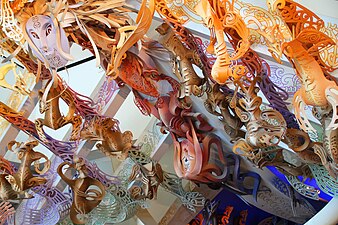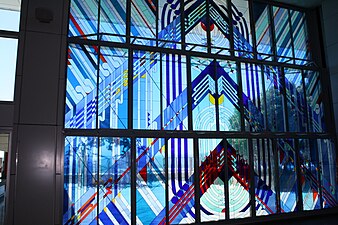
Rongomaraeroa is the marae of the Museum of New Zealand Te Papa Tongarewa and incorporates a contemporary wharenui (meeting house) Te Hono ki Hawaiki. It is located on the museum's 4th floor overlooking Wellington harbour, and was officially opened on 30 November 1997.
The design, described as "postmodern", was overseen by Te Papa's inaugural kaihautu (Māori leader), master carver Cliff Whiting. As "the only one of its kind expressly built for that purpose in a museum", this marae is "arguably the most prominent embodiment of commitment to biculturalism".
In October 2020, the Government committed $887,291 from the Provincial Growth Fund to upgrade the marae and 4 others in the Central Hawke's Bay area, creating 12 jobs.
Purpose and usage

Rongomaraeroa is used for many events, not only as a museum exhibit – it was always intended to be a "'living marae' used for pōwhiri, functions, and tangi". For example, in May 2017 and July 2018 the marae was the site of ceremonies of repatriation of Māori and Moriori remains – including toi moko – from several European and American institutions. Rongomaraeroa is unique in its ability to serve as the location for such ceremonies as it is a "nationalised, pan-iwi marae". As traditional gathering spaces, marae are always located on the ground. However, given the situation of this one on an upper level of the building, Whiting nicknamed Rongomaraeroa "the marae in the sky". The name also helped to differentiate it as a marae belonging to the museum "with its own special Te Papa kawa ", and not to Te Āti Awa – the local iwi of the Wellington area. Although initially controversial and charged with being a "reappropriation" of complex Māori practices and protocols "...to serve its reconciliatory, bicultural remit, often at the expense of more contested issues such as Māori self-determination...", it is now widely accepted as a genuine marae, "by intention if not by inheritance". Rongomaraeroa is also available for hire from Te Papa for commercial and private events.
Te Hono ki Hawaiki is not to be confused with the traditional wharenui of the Rongowhakaata iwi: Te Hau ki Tūranga. Dating from the 1840s, this is the oldest extant carved meeting house and is on long-term loan to Te Papa. It is displayed in the nearby exhibition of Māori culture Mana Whenua.
Design
Rongomaraeroa has a usable space of 350m² and can accommodate 250 people. Carvings for the wharenui were made by Whiting using the non-traditional material medium-density fibreboard (MDF) rather than rare native timber. This enabled the forming of unusual and elaborate three-dimensional shapes. Non-traditional colours as well as European, Asian, and Polynesian design references were incorporated in order to include all cultures of contemporary New Zealand. "It reflects the nation's bicultural foundations while embracing everyone. It's innovative in its story-telling and its design... extended the boundaries of Māori art by using contemporary materials and resources" stated his successor Arapata Hakiwai in 2013. For example, the wharenui includes a triptych shrine featuring a Christian dove, "in order to come up with something that not only Māori could relate to but Europeans as well."
Carvings in arches and pillars of Te Hono ki Hawaiki representing Māori myths and legends include:
- The story of Māui slowing the sun depicted on the maihi of the wharenui.
- The story of the creation of the first woman, Hineahuone, by her father Tāne Mahuta the god of the forest, represented in the doorway.
- Māui turning his brother-in-law, Irawaru, into a dog.
- The story of Paikea the whale rider.
- And "the changing relationship between Māori and Pākehā is portrayed inside the cupboards housed in the poutokomanawa (the central heart post of the meeting house)".
Guests can be ceremonially lead up to the marae space without having to go through other exhibitions which was a design consideration to support pōwhiri.
-
 Detail of the contemporary carvings by Cliff Whiting on the wharenui.
Detail of the contemporary carvings by Cliff Whiting on the wharenui.
-
 detail of the stained glass door, depicting Ranginui (the sky father). When opened, "it pushes upwards away from the flooring (which depicts Papatūānuku, the earth mother), re-enacting the traditional Māori story of separation."
detail of the stained glass door, depicting Ranginui (the sky father). When opened, "it pushes upwards away from the flooring (which depicts Papatūānuku, the earth mother), re-enacting the traditional Māori story of separation."
-
 Tukutuku on the walls. Made by students of Toi Haukura.
Tukutuku on the walls. Made by students of Toi Haukura.
-
 Panels on the opposite wall.
Panels on the opposite wall.
Naming
In Māori mythology, Te Hono ki Hawaiki refers to Hawaiki – the original home island of all Polynesians – while Rongomaraeroa is another name for Rongo, the god of kūmara and other cultivated food. Rongomaraeroa is also the name given to the marae belonging to several hapū of the Ngāti Kahungunu and Heretaunga Tamatea iwi along the South-Eastern coastline of New Zealand's North Island.
See also
References
- ^ "Te Marae". Museum of New Zealand Te Papa Tongarewa, Wellington, NZ. 22 December 2015. Archived from the original on 16 February 2020. Retrieved 14 March 2020.
- "Our building". Museum of New Zealand Te Papa Tongarewa, Wellington, NZ. 10 February 2016. Archived from the original on 5 February 2020. Retrieved 16 February 2020.
- ^ "Rongomaraeroa – self-guided education visit". Museum of New Zealand Te Papa Tongarewa, Wellington, NZ. 8 June 2016. Archived from the original on 19 January 2020. Retrieved 14 March 2020.
- ^ Alivizatou, Marilena (2016). "From artefacts to communities: Participation and Contestation at Te Papa Tongarewa". Intangible heritage and the museum : new perspectives on cultural preservation. London: Routledge. p. 56. ISBN 978-1-315-42637-2. OCLC 954006713.
- "He Mātanga Toi – Dr Cliff Whiting". RNZ. 21 July 2017. Retrieved 14 March 2020.
- ^ McCarthy, Conal (2016). Museums and Māori : heritage professionals, indigenous collections, current practice. Abingdon, Oxon: Routledge. p. 143. ISBN 978-1-315-42389-0. OCLC 954006975.
- ^ Schubert-McArthur, Tanja (2019). "3. Performing Biculturalism: Creating Te Marae and conducting Pōwhiri". Biculturalism at New Zealand's national museum: an ethnography of Te Papa. London: Routledge. ISBN 978-1-351-12136-1. OCLC 1090060351.
- "Marae Announcements" (Excel). growregions.govt.nz. Provincial Growth Fund. 9 October 2020.
- "Moriori and Māori ancestors offered dignity and respect". Museum of New Zealand Te Papa Tongarewa, Wellington, NZ. 29 May 2017. Archived from the original on 23 March 2019. Retrieved 14 March 2020.
- "Māori and Moriori ancestral remains offered respect and dignity". Museum of New Zealand Te Papa Tongarewa, Wellington, NZ. 13 July 2018. Archived from the original on 15 January 2020. Retrieved 14 March 2020.
- Katz, Brigit. "Preserved Māori Head Returns to New Zealand". Smithsonian Magazine. Archived from the original on 1 June 2019. Retrieved 14 March 2020.
- Zoe, Alderton (2 June 2014). "The Secular Sacred Gallery: Religion at Te Papa Tongarewa". In Heartney, Christopher (ed.). Secularisation: new historical perspectives. Newcastle upon Tyne. p. 265. ISBN 978-1-4438-6120-5. OCLC 881184130.
{{cite book}}: CS1 maint: location missing publisher (link) - ^ "Function venue: Te Marae". Museum of New Zealand Te Papa Tongarewa, Wellington, NZ. 8 January 2016. Archived from the original on 15 February 2020. Retrieved 14 March 2020.
- Jody Wyllie and Te Hau ki Tūranga (20 June 2018). "OURS: Treasures from Te Papa". RNZ. Retrieved 15 March 2020.
- "Modern marae: Te Hono ki Hawaiki". Te Ara. Archived from the original on 23 January 2019. Retrieved 14 March 2020.
- "Te Maori: Insight into Cliff Whiting's work". NZ Herald. 26 November 2013. ISSN 1170-0777. Archived from the original on 7 January 2014. Retrieved 14 March 2020.
- Bennett, Adrian John Te Piki Kotuku (2007). Marae: a whakapapa of the Maori marae (Thesis). University of Canterbury. doi:10.26021/4845.
- "Rongo-marae-roa – Māori Dictionary". maoridictionary.co.nz. Archived from the original on 6 February 2020. Retrieved 14 March 2020.
- "TKM | Iwi | Heretaunga Tamatea | Te Kahui Mangai". www.tkm.govt.nz. Archived from the original on 21 January 2020. Retrieved 14 March 2020.
- "TKM | Iwi | Ngāti Kahungunu | Te Kahui Mangai". www.tkm.govt.nz. Archived from the original on 21 January 2020. Retrieved 14 March 2020.
External links
- Te Marae at Te Papa Tongarewa's website
| Māori | |
|---|---|
| Indigenous people of New Zealand (Aotearoa) | |
| History | |
| Society | |
| Politics | |
| Culture | |
| Arts | |
| Science | |
| Sport |
|
| Language | |
41°17′26.32″S 174°46′55.43″E / 41.2906444°S 174.7820639°E / -41.2906444; 174.7820639
Categories: